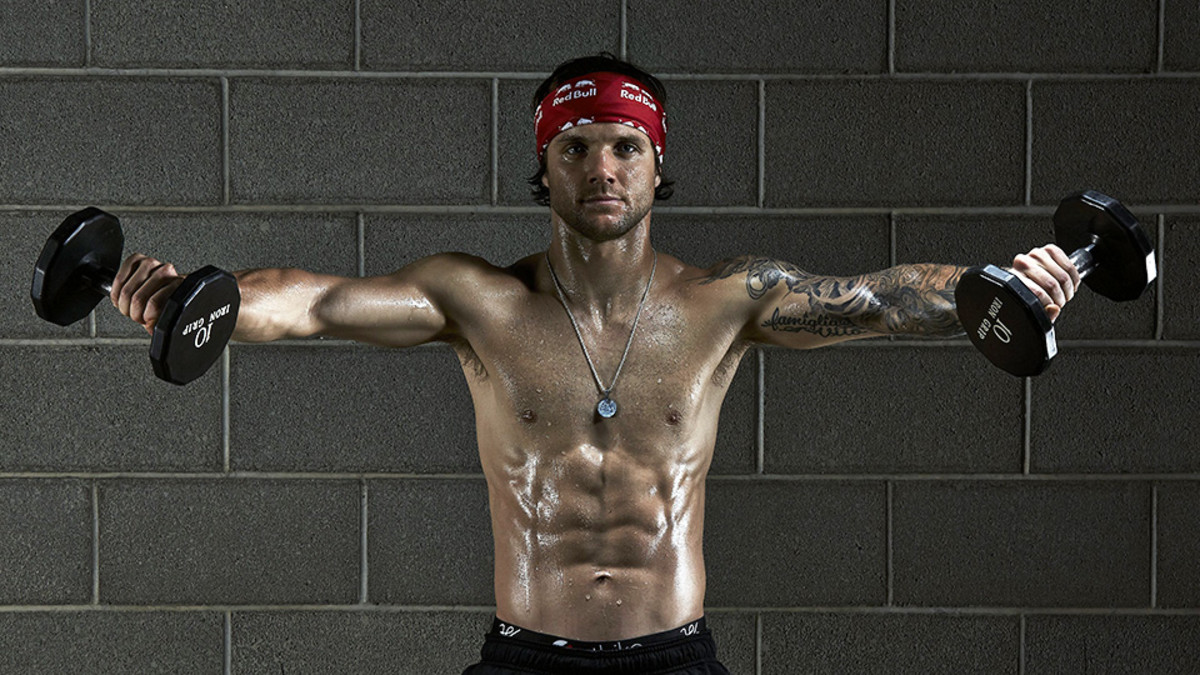Louie Vito breaks down his training ahead of Wings for Life World Run
The book is unassuming. It's a three-ring binder, really, filled with hundreds of papers scribbled with notes and separated by tabs—a sight you would see at a college student's final cram session before the big test.
But snowboarder Louie Vito isn't studying for exam, or organizing office documents. He's preparing for a workout.
Now a student of fitness—coached by John Schaeffer of Winning Factor for about four years—Vito follows a comprehensive training program similar to the one Schaeffer developed for Apolo Ohno prior to the 2010 Olympics. While Schaeffer prepared Ohno's program three years in advance of the Games, Vito's book contains about six months' worth of daily exercises, menus and nutrition guidelines, recovery plans and more. He doesn't go anywhere with out it.
"It’s almost a way of life—when I’m home, traveling or wherever, everything I do is based on the book,” says the Olympic gold medalist and Winter X Games champion. “It travels with me and I keep notes about progress, sleep, or workouts that really killed me. It's a good way to look back and pinpoint different things.”
Eric Koston's mission to bring skateboarding and art to the people
The 27-year-old typically starts his day with a progressive interval workout on the treadmill: 40 seconds of sprinting and 40 seconds of recovery running—equivalent to the length of an average halfpipe run—steadily increasing speed over a maximum of 20 rounds. Schaeffer says he will start at 6-8 mph and end at 10-14 mph, with the recovery speed at 11 mph by the end of the session. "There's no chance to catch your breath, you're always pushing to the limit," says Vito.
After a healthy post workout meal—lean proteins, vegetables—Vito usually goes for a ride and then rests a bit before hitting the gym for a lift. The session almost always focuses on explosiveness. With Jim Jones or Meek Mill blaring in his headphones, Vito uses weighted plyometric movements to mimic the intensity of landing on a half pipe after flying more than 20 feet in the air.
"I've noticed that I can take the heavy impact of a huge load on a flatter landing and my body isn’t jacked up from landing flat,” says Vito. “I can handle it better because of the training we do."
One of Vito's go-to exercises for training explosiveness is single and double leg hops on the stairs while holding dumbbells weighing up to 100 pounds. Different modifications include jumping every other, every third or even every fourth step and varying the weight in hand.
"It's my favorite exercise because when you're able to jump five steps with weights and you're 5’6" on a good day, it's crazy, especially when your legs are already fried," says Vito.
Schaeffer also incorporates standard weight lifting exercises into Vito's program, but there is always an added element to bring in the explosiveness factor. In a traditional leg press, for example, Schaeffer builds in "throws” to increase power and strength. Instead of returning back to a starting position at the top of a leg press, Vito pushes off of the platform, presses the weight up—completely off of his feet and airborne—and then catches it again at the bottom.
[daily_cut]
"The thing about John's workouts is that they are short and intense—I'm not at the gym for one and a half hours," says Vito. “During certain exercises, you learn how to shut your mind off. It’s such a trippy feeling to be able to push through that wall.”
After years of intense training, Vito is confident he is he fittest snowboarder competing today—"I challenge anyone to come do what I do"—and he knows that the longevity of his career is closely related to remaining healthy and injury-free. But Vito also knows that despite how hard he works in the gym, a career in action sports is dangerous and can be cut short at any moment, which is why he will participate in the Red Bull Wings for Life World Run for the second year in a row on May 3.
"Spinal cord injuries are pretty common in action sports and it's a tight, small community, so it hits a soft spot for me," says Vito of the race, which is held simultaneously in 35 global locations and donates 100% of the proceeds to spinal cord research.
In its inaugural race last year, more than 35,000 participants raised more than $4.1 million. Vito started his race in 2014 in Denver with a five to eight mile goal and completely surpassed it, running 13.22 miles.
Since then, Vito’s workouts have remained structured and dictated by his book and he’s approaching this year's Wings for Life World Run with the same attitude and strategy.
"I'm sticking to my program and not doing anything different to train for the race, but I guarantee that I will run the entire time, for those who are unable to. I'm not gonna walk," says Vito, who will start the race in Santa Clarita, Calif., on Sunday. "I'm just kind of gonna wing it."






